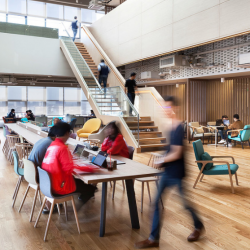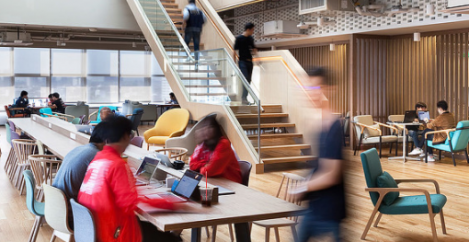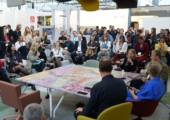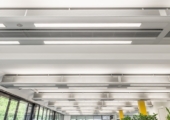January 24, 2023
Offices valued as a place to get work done, not just connect
 The latest Workplace Survey from the Gensler Research Institute sets out to explore how employees are spending their time as they return to the office, how offices can more successfully support them, and the strategic design interventions that will have the biggest impact on the workplace experience. As companies consider the future of their workplaces, the new data suggests that U.S. employees are looking for offices that are both highly effective and offer a desirable mix of experiences. The highest-performing workplaces are those that support all modes of work, offer a wide range of experiences, and are located in amenity-rich buildings and/or neighbourhoods.
The latest Workplace Survey from the Gensler Research Institute sets out to explore how employees are spending their time as they return to the office, how offices can more successfully support them, and the strategic design interventions that will have the biggest impact on the workplace experience. As companies consider the future of their workplaces, the new data suggests that U.S. employees are looking for offices that are both highly effective and offer a desirable mix of experiences. The highest-performing workplaces are those that support all modes of work, offer a wide range of experiences, and are located in amenity-rich buildings and/or neighbourhoods.
“The data illustrates that employees are looking for offices that are both effective in supporting their ability to focus on their work and offer a more desirable mix of experiences,” said Janet Pogue McLaurin, Global Director Workplace Research, Principal, Gensler. “Understanding how workers spend their time and what experiences and work settings they need to perform best is critical for business performance and employee engagement.”
Key findings of the survey include:
The primary reason that workers come to offices has shifted since the height of the pandemic, and as employees have begun to spend more time working from the office. Employees now prioritise the desire to focus on their work in the office above connecting and collaborating.
- “To focus on my work” is currently the most important reason employees see for coming to the office. Additional top-ranked reasons center on intentional-based activities such as access to technology, scheduled meetings, and access to specific spaces, materials, and resources.
- The workplace is increasingly effective in supporting activities that require working with others in-person but working alone and working with others virtually continues to decline in effectiveness, a trend already underway pre-pandemic.
- Spaces designed to support a) working independently and b) virtual collaboration offer a particular opportunity for positive impact on worker effectiveness and experience. Employees rate both focused work and virtual collaboration as critical to their job performance; on average, 34 percent of the work week is spent working individually, and 56 percent of meetings in the office are hybrid requiring the spaces and technology to meet the new performance demands.
- Support for individual work is particularly critical for younger and non-managerial workers – time spent working with others virtually, learning and socializing increase with seniority of roles.
Many workers believe they should be working from the office more—better quality work environments would encourage them to do so.
- Workers in high-performing workplaces say they prefer to be in the office almost one day more a week to optimize their team and individual productivity.
- Employees in high-performing workplaces are more likely to prefer the office for focused work activities such as deep concentration, writing, and taking phone calls.
- Workers in high-performing workplaces are 2x as likely to say that working in the office environment positively impacts organisational outcomes such as speed of decision-making, quality of work, and team productivity, compared to workers in the low-performing workspaces.
Employees say they would come to the office more often for their ideal mix of experiences.
- Respondents not currently working from the office full-time noted that a new mix of work experiences would draw them back to the office more.
- 83 percent of employees say they would return to the office at least one additional day per month if their office provides their ideal mix of experiences.
- Younger generations prefer hospitality-focused experiences, while older workers prefer a blend of corporate and hospitality-focused experiences.
Workplaces that are both effective and offer great experiences have access to diverse work settings.
- Spaces for creative group work and individual work have the most significant impact on space effectiveness and experience.
- Effective workplaces that provide great experiences are more likely to be in neighborhoods that have access to a range of amenities including coffee shops, outdoor spaces, and eateries.
The Gensler Research Institute conducted an anonymous, panel-based survey of over 2,000 U.S. adults in the U.S. between June 14, 2022, and August 7, 2022. Respondents excluded workers who have not yet returned to the office since the start of the pandemic.












